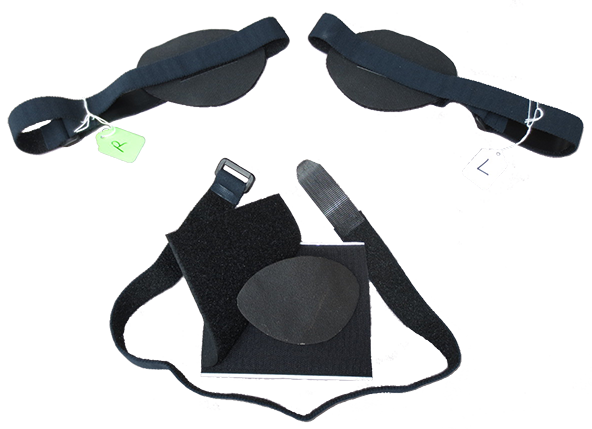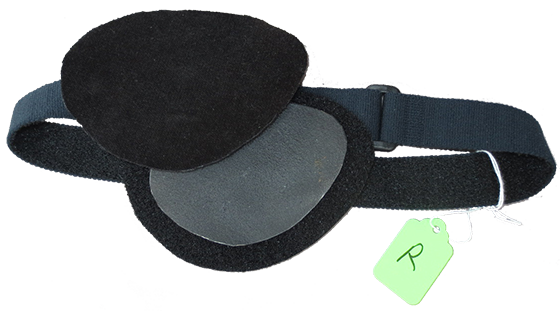The Eye Physics Model 1 shields are essentially oversized lead lined "pirate patches" (as in arrggghhhh matey). The attenuating component is composed of 0.89 mm thick RADMAX lead sheet from United Nuclear.

The half-value layer (HVL) of I-125 emissions is about 0.025 mm Pb so attenuation (by the 0.89 mm thick insert) of primary radiation emitted from a plaque that intersects the shield is essentially 100% (about 34 HVLs). However, some primary emission may geometrically miss the insert and some secondary scatter will make its way around the insert.
We spray the lead sheet with a rubber coating so that it may be safely cut and otherwise shaped using hand tools. The roughly 10 x 7 cm ovately shaped lead (Pb) insert is sandwiched between layers of nylon velcro sheeting. The coating and sandwich arrangement minimizes the chance of direct physical contact with metallic lead.
The shields are available in mirror-image configurations designed for either the left (PN EPShield1-L) or right (PN EPShield1-R) eye. The shields are held in place over the eye by a 2.5 cm wide by 68.5 cm long Velstretch® strap that attaches to the front of the shield and wraps around the head. The orientation at the attachment point and the circumference (hat size) created by the assembled strap are both adjustable velcro fittings. The reverse side of a shield where it comes in contact with the forehead and nose is adhesively lined with microfiber cloth for comfort. Perhaps of interest, the only tool used by Eye Physics to assemble a shield is a pair of very sharp titanium coated scissors!
Eye Physics shields are a "one-size-fits-all" design. A common plastic or aluminum ophthalmology shield and layers of sterile gauze padding are to be placed underneath the EP leaded shield, i.e. in-between the eye and the backside of the leaded shield. The EP shields are NOT intended to be sterilized because they are applied only after all sterile field tasks of the surgical procedure have been completed. Sterilization procedures that employ heat or liquids will likely severely damage the nylon, plastic and adhesive components of the shield assembly.
The outer velcro shell and strap that come in contact with the patient are intended for single patient use only and should be disposed of after conclusion of treatment.
When used as intended, the internal lead insert should never come in contact with the patient and it is intended to be reused. When provided as an accessory to a pre-loaded rental plaque, the lead insert should be returned to IsoAid along with the plaque. It can be removed before disposing of the outer velcro shell by simply pealing open the velcro shell. The rubber coating on the insert greatly reduces (but does not completely prevent) physical contact with the metallic lead when handling the insert. You may optionally keep the lead insert and reuse it for subsequent patients by ordering replacement velcro outer shells at a much reduced cost. The lead insert is universal in that it works with both left or right eye shells by simply flipping it over. The lead insert may be gently washed in soapy water taking care not to scrape off the rubberized coating.
(PN EPShield1-R) (PN EPShield1-L)


Reverse side view of a disassembled shield. The back side of the velcro shell that comes in contact with the forehead and nose is lined with microfiber cloth. The rubber coated lead insert is recovered by disassembling the velcro shell. The inserts are intended to be reused to help protect the environment from lead contamination and reduce treatment costs.